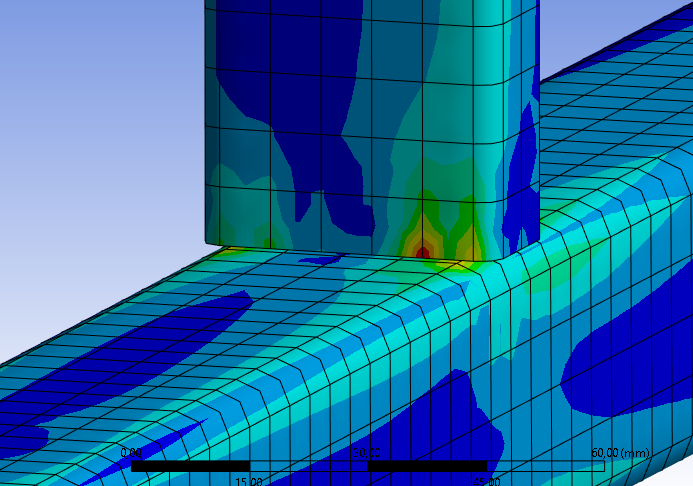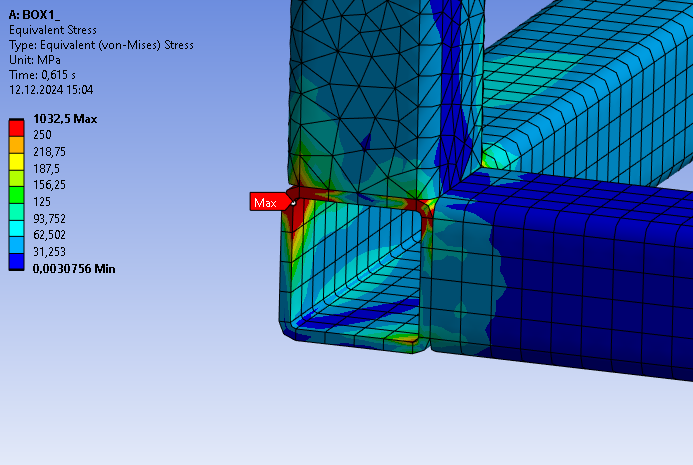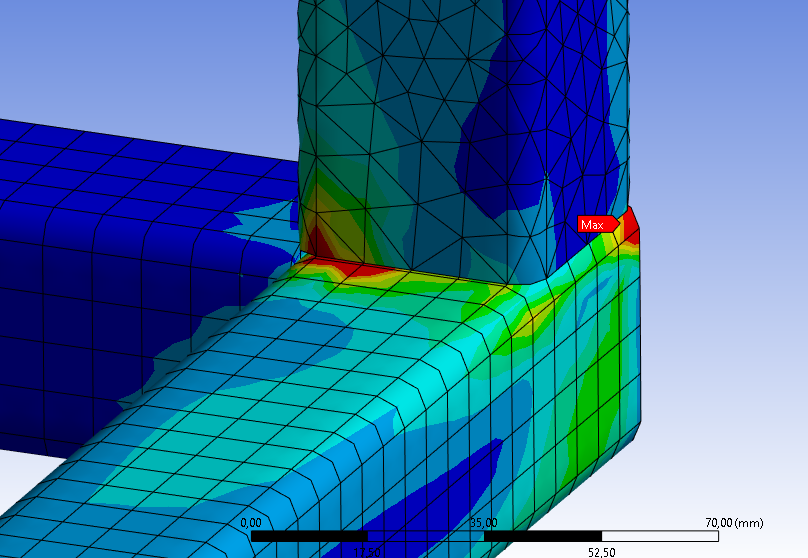-
-
December 12, 2024 at 5:30 pm
javat33489
SubscriberHello everyone.
When calculating steel frames made of steel sections, I often encounter stress concentrators at the end of a pipe or at the contact where the pipe does not fit onto a curved surface:Please give me your advice on how to avoid this?
1. Sometimes I use a stiffness factor of 0.02 and this helps to avoid a concentrator at the contact. Is this normal?
2. I tried to make the mesh at the ends of the pipe finer, but this does not help
3. I tried asymmetric
4. I tried different types of contacts (normal Lagrange, extended Lagrange)
5. I did a lot of tests, but this did not help.Please give me your advice on how to avoid this?
If this were only in one place, I could close my eyes to it and not take it into account and examine the rest of the structure, but this is a big hindrance.
Thank you. -
December 13, 2024 at 7:26 am
Kaushal Vadnere
Ansys EmployeeHello,
As your pipes have sharp edges at the contact, stress concentration is expected. Reducing Normal stiffness factor may help reducing the as it allows for some penetration, but you have to balance it with the need for accuracy in your simulation.
There are general tips to deal with stress singularities, you can add fillets to replace sharp edges, use the stress of nearby elements to approximate the stress at singularity regions. And if you are not interested in stress distribution in the thickness direction of the walls of steel frame, you can use shell element formulation. So, you can use finer and good quality mesh.Please refer to this free Ansys Innovation course to learn more about how to deal with such stress singularities and best practices: https://innovationspace.ansys.com/product/numerically-accurate-results/
Join structures Community feed: https://innovationspace.ansys.com/community/groups/?structures-community/ -
December 13, 2024 at 7:43 pm
peteroznewman
SubscriberHello Javat,
Your model shows three square tubes coming to a corner with bonded contact to hold them together.
This model is a simplification of reality, and is useful to look at overall stiffness of the frame structure. It is also useful to look at stress along most of the tube length if you ignore the tube ends near the bonded contact for about 2 diameters of the tube. You can call this the System Model. One method to exclude stress results from the ends of the tube is to prepare the geometry in SpaceClaim where you can set up planes 2 diameters from each end to slice the body into two pieces, then use the Share button on the Workbench tab to have the mesh connect the two pieces into one mesh. In Mechanical, make a Named Selection of the tube bodies that are the long middle pieces and don’t select the tube bodies at the ends where the bonded contact exists. That way the plots will not show the unrealistic stresses at the ends.
In reality, the tubes are welded along at least two opposite edges and stress in the welds can be evaluated separately from the finite element model in a hand calculation. Weld strength is evaluated using the average stress in the weld bead throat. The inputs to the hand calculation is the average shear and normal forces in the plane of the weld bead throat. To separate shear and normal forces, you need a coordinate system aligned with the weld bead throat. Average stress is force divided by area. Several national codes specify how weld strength is to be evaluated. The point is the finite element model provides the sum of the shear forces and normal forces going through the weld bead. You don’t need to evaluate stress in the elements of the weld bead.
One simple way to get the forces going through the weld bead is to use a Fixed Joint scoped to the edge on one side of the tube, and a matching length of corner edge of the mating tube that the weld bead connects. Probe the forces going through the Fixed Joint to get the input values to the weld strength hand calculation. This is only appropriate for a short length of weld bead. It is inappropriate for a long weld bead, where several short lengths should be created to get a local value of force being carried by the weld bead since there is often a higher force near one end of the bead which you don’t want to average away in a long fixed joint.
For other techniques, read this discussion, which has two links of interest.
-
December 14, 2024 at 5:31 pm
javat33489
SubscriberThank you very much professionals!
-
- You must be logged in to reply to this topic.


- LPBF Simulation of dissimilar materials in ANSYS mechanical (Thermal Transient)
- Nonlinear load cases combinations
- Real Life Example of a non-symmetric eigenvalue problem
- How can the results of Pressures and Motions for all elements be obtained?
- Contact stiffness too big
- Test post on Forum – LLM response – SC
- 13-Node Pyramid Element Shape Function
- Element Birth and Death
- Python-Script to Export all Children of a Solution Tree
- Which equations and in what form are valid for defining excitations?

-
4562
-
1494
-
1386
-
1209
-
1021

© 2025 Copyright ANSYS, Inc. All rights reserved.










